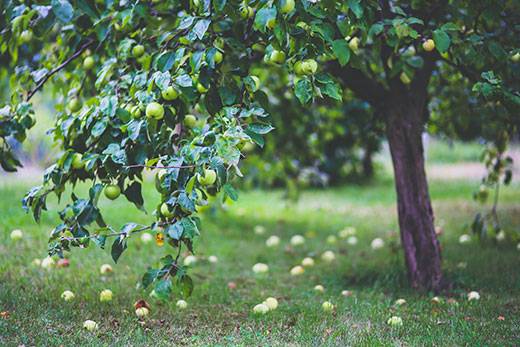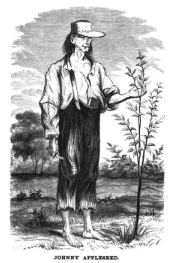Johnny Appleseed

One of my favorite childhood stories was the tale of Johnny Appleseed spreading apples across the United States. The thought of someone selflessly planting apple trees to help others resonates with many across the country. If you didn’t know, the story of Johnny Appleseed is based on a real-life person who spread apples across the eastern part of the United States. While history remembers him as a wanderer, he was actually a careful businessman. In honor of his birthday this week, let’s explore the history of Johnny Appleseed.
Johnny Chapman, who would later get the nickname Johnny Appleseed, was born September 26, 1774, in Massachusetts on the family farm. His adventures didn’t start till 1794 when he was 18, and Johnny, with his 11-year-old brother Nathaniel, traveled west following a steady stream of immigrants. He would carry a leather bag of apple seeds he received from cider mills and would use them to plant apple orchards as he traveled around the country. While the story of Johnny Appleseed makes it seem like he planted apple seeds at random to feed communities, he did so with a strategic business plan. Johnny would carefully cultivate his apple “nurseries” to develop as orchards for several reasons. Orchards were an essential part of establishing the legal ownership of land. To prove their homesteads to be permanent, settlers were required to plant 50 apple trees and 20 peach trees in three years since an average apple tree took roughly ten years to bear fruit. Johnny would do the difficult work of planting the orchards on the property and then sell it to future settlers. He planted cider apples in his orchards because hard apple cider was an essential part of the American table at the time. They left the alcohol aspect out of my childhood story of Johnny Appleseed.
in Massachusetts on the family farm. His adventures didn’t start till 1794 when he was 18, and Johnny, with his 11-year-old brother Nathaniel, traveled west following a steady stream of immigrants. He would carry a leather bag of apple seeds he received from cider mills and would use them to plant apple orchards as he traveled around the country. While the story of Johnny Appleseed makes it seem like he planted apple seeds at random to feed communities, he did so with a strategic business plan. Johnny would carefully cultivate his apple “nurseries” to develop as orchards for several reasons. Orchards were an essential part of establishing the legal ownership of land. To prove their homesteads to be permanent, settlers were required to plant 50 apple trees and 20 peach trees in three years since an average apple tree took roughly ten years to bear fruit. Johnny would do the difficult work of planting the orchards on the property and then sell it to future settlers. He planted cider apples in his orchards because hard apple cider was an essential part of the American table at the time. They left the alcohol aspect out of my childhood story of Johnny Appleseed.
Johnny planted his orchards along the routes that pioneers used to move west, allowing him to stay ahead of other orchards that might come in later to compete for cider production. Because he was unmarried, he was able to have a nomadic lifecycle and moved with the settlers. At the time of his death, Johnny owned a lot of land throughout Pennsylvania, Ohio, and Indiana. Why did he only plant seeds for his orchards instead of grafted plants? Johnny’s religious beliefs at the time forbade grafting as his church felt that caused the plants to suffer. Due to his religious beliefs, he was a vegetarian and staunch animal welfare supporter.
Johnny Chapman was not just a good businessman; settlers also loved him because he shared news and information from surrounding communities and served as a missionary for his church. He often gave seedlings to struggling pioneers and was known to give his nice clothes to people he deemed needed more. This generosity is the origin of his story: he wore no shoes, had a tin hat, and wore gunny sacks for clothes. Throughout his life, he would spend 50 years traveling, developing fruit orchards before he retired and moved back in with his brother Nathaniel, who helped him start his remarkable journey. Johnny died in March of 1845 in Indiana, leaving behind a legacy of apples throughout the Midwest.
While my childhood story of Johnny Appleseed is not entirely correct, the history of what Johnny Chapman did and his methods of planting orchards are still just as fascinating now as the original story I heard. Even though he planted cider apples that weren’t fit for eating, I hope you will celebrate his birthday by eating an apple in his memory.

Have questions? Contact our office where our Horticulture Extension Agent will assist you with questions.
Phone: (316) 321-9660
Email: callae@ksu.edu